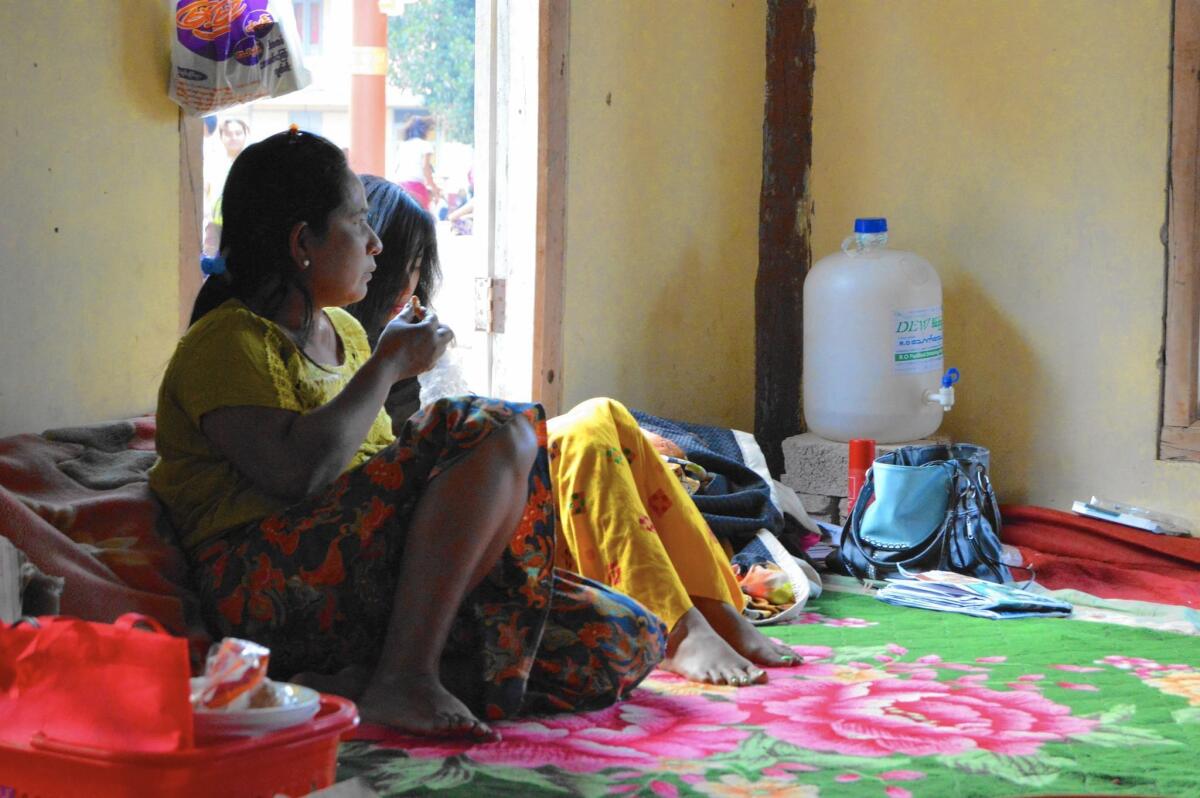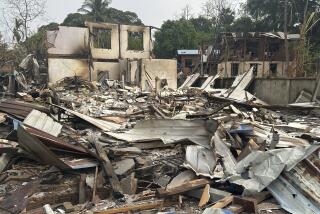Myanmar conflict with Kokang rebels may test draft cease-fire pact

People fleeing the fighting between Kokang rebels and Myanmar government forces have sought refuge at the Mansu Monastery in Lashio.
Reporting from LASHIO, Myanmar — Wang Jia’s life in the northern Myanmar city of Laukkai was the picture of normality. The 40-year-old mother of four watched her 5-month-old son and her three other children. Her husband, a farmer, kept busy slaughtering pigs.
But when fighting erupted in early February between an ethnic Chinese militia and government troops, Wang and her husband piled what they could into their orange three-wheeled motorized cart and drove their children four hours south to Lashio, taking shelter at the Mansu Monastery.
“All our neighbors have left, and we’ve heard our house has been looted — the furniture and everything,” Wang said, rocking her infant son in a makeshift hammock in the crowded barracks-style hall she shares with dozens of other families. Outside by some water taps, women took sponge baths. In the yard, children sucked on Popsicles and played soccer. “We don’t know when we can go home.”
Wang is one of about 20,000 people who have come to Mansu Monastery in the last eight weeks — some walking up to 100 miles — as battles raged in northern Shan state, head monk Ponnya Nanda said. Most quickly moved on to other accommodations, but more than 200 remained this week. Tens of thousands other refugees have crossed into China.
After more than 16 months of negotiations, Myanmar’s government and representatives of more than a dozen ethnic militia groups announced this week that they had reached preliminary agreement on a nationwide cease-fire, though leaders of the various groups must still formally sign on. For a country long riven by conflict and divided into ethnic fiefdoms, concluding such a pact would be a landmark achievement before November elections.
A cease-fire would help set the stage for a free and fair vote, a prerequisite for Western governments and foreign investors as they weigh deeper engagement with Myanmar, which transitioned to a nominally civilian government in 2011 after decades of military rule.
But obstacles remain to truly silencing all guns across the country, and the conflict that displaced Wang and her family is a key test.
For starters, the ethnic Chinese militia fighting in Wang’s city has been excluded from cease-fire talks. Government officials argue that the battle in the Kokang region is a matter of national sovereignty, not an internal conflict, and that Kokang rebel leaders rebuffed an offer of talks three years ago.
The Kokang fighters, like many people in the border region, speak Mandarin and have historic links to China, though Beijing has denied giving official support to the group. Their leaders insist they do not seek independence, just the right to self-rule in a federal-style system.
The government, though, portrays them as an invading force sponsored by Beijing. The military has launched a fierce offensive, including airstrikes, to root out the group, which claims to have about 2,000 men under arms.
How long it might take to defeat them is unclear. Already, other small ethnic groups excluded from cease-fire talks have come to the aid of the Kokang.
“It’s possible to have a nationwide cease-fire and still be fighting the Kokang — they are considered a renegade group,” insisted Aung Naing Oo, a government observer in the talks.
The leaders of the 16 ethnic armies that have been invited to sign the cease-fire pact are due to meet in April, and Western diplomats hope an agreement will be concluded within several weeks. But Khun Okker, co-chairman of the rebels’ negotiating team, signaled that some militia leaders would not sign while the army was bombing areas such as Kokang.
“Even with an agreed text, we still need the right circumstances to sign. We need stability and peace on the ground,” he said.
Min Zaw Oo, a former rebel who serves as director of cease-fire implementation for the government, echoes the contention that the Kokang passed up the opportunity to negotiate. “We can only facilitate peace when both sides are willing to talk,” he said.
Even if the 16 ethnic militia leaders do sign the cease-fire text, key issues such as the timing and terms of the ethnic minority fighters’ disarmament and potential integration into national security services remain to be decided.
Government negotiators initially demanded that rebels disarm as a condition of a cease-fire, but recently softened that position, paving the way for the draft agreement reached this week.
“Without arms in our hands we have no political rights,” Khun Okker said. “We know this from experience.”
Myanmar has 135 officially recognized ethnic groups, but ethnic Bamar constitute nearly 70% of the population of about 51 million and dominate the powerful military. The army has fought dozens of armed ethnic groups over the years and signed dozens of bilateral truces, many of which have been broken.
As the peace process moves forward, experts say ethnic groups have reason to be cautious as the military has a reputation for committing abuses in minority areas.
Global Witness, a watchdog group, said in a report last week that 5.3 million acres of farmland seized by army forces beginning in 2006 in northeastern Myanmar had been converted into rubber plantations. As of 2013, the plantations were owned by a company that now employs the army major who led the seizures, the group found.
How fully the army can integrate fighters from ethnic militias also remains unclear; ethnic minorities in the military say they face discrimination.
“We cannot advance past the rank of colonel,” said one ethnic Rakhine officer who requested anonymity to protect his job. “They are suspicious of us.”
Significantly, the 21-page draft agreement states that the peace process will lead “to a union based on democratic and federal principles,” the first time that the government, still dominated by the military, has signaled a willingness to devolve power in a federal system.
It also calls for committees to monitor the cease-fire and to organize peace talks, and establishes rules governing the conduct of the government and ethnic armed groups during the truce.
“We have a lot of work to do,” said Min Zaw Oo, the former rebel. “But now we have something we can implement to start the political dialogue.”
For Mar Mar Soe, 40, who, like Wang Jia, is among those sheltering at the monastery in Lashio, peace cannot come soon enough. The ethnic Bamar woman has been away from home since mid-February, but her 18-year-old son recently returned to the conflict zone to check on their house.
“The rebel leader should not fight; he should negotiate with the government,” she said. But if that wasn’t possible, she hoped the army could prevail quickly.
“If the government can win, everything will be peaceful again,” she said. “I think there will be peace in Myanmar, but it will be very difficult.”
Paluch is a special correspondent.
Twitter: @JulieMakLAT
Twitter: @SBengali
More to Read
Sign up for Essential California
The most important California stories and recommendations in your inbox every morning.
You may occasionally receive promotional content from the Los Angeles Times.












